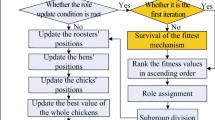Abstract
Pulse-coupled neural network (PCNN), which simulates the synchronous oscillation phenomenon in the visual cortex of small mammals, has become a useful model for image processing. In the model, several parameters were usually required to properly set for adjusting the behavior of neurons. However, undesired behavior may occur owing to inappropriate parameters setting. To alleviate this problem, we propose to simplify some parameters of PCNN, and apply it into image segmentation. First, exponential delay factors are abandoned for adjusting the neuron input, and the neural input is then associated with image information as well as pulse output. In addition, neural threshold inherent in PCNN is simplified as an adaptive threshold related to image properties, allowing our model to easily alter the behavior of neurons. Particularly, the characteristic of synchronous pulse is thereby kept by introducing a fuzzy clustering method, instead of linking coefficient for grouping pixels with similarity and spatial proximity through iterative computation. Experimental results on synthetic and real infrared images show that the proposed model has high performance of segmentation. Furthermore, our model has better adaptability for segmenting real-world images when compared with several existing PCNN-based methods and some classic segmentation methods.























Similar content being viewed by others
References
Eckhorn R, Reitboeck HJ, Arndt M, Dicke P (1990) Feature linking via synchronization among distributed assemblies: simulations of results from cat visual cortex. Neural Comput 2(3):293–307
Wang Z, Ma Y, Cheng F, Yang L (2010) Review of pulse coupled neural networks. Image Vis Comput 28(1):5–13
Subashini MM, Sahoo SK (2014) Pulse coupled neural networks and its applications. Expert Syst Appl 41(8):3965–3974
Shen Y, Zhang X, Han K et al (2014) Research of image segmentation technology based on PCNN. Mod Electron Tech 37(2):38–41
Sezgin M, Sankur B (2004) Survey over image thresholding techniques and quantitative performance evaluation. J Electron Imaging 13(1):146–165
Wei S, Hong Q, Hou M (2011) Automatic image segmentation based on PCNN with adaptive threshold time constant. Neurocomputing 74(9):1485–1491
Rava TH, Bettaiah V, Ranganath HS (2011) Adaptive pulse coupled neural network parameters for image segmentation. World Acad Sci, Eng Technol 73:1046–1052
Chen Y, Park SK, Ma Y, Ala R (2011) A new automatic parameters setting method of a simplified PCNN for image segmentation. IEEE Trans Neural Netw 22(6):880–892
Kinser JM (2002) A simplified pulse-coupled neural network. In: Proceeding of SPIE, Orlando FL, USA, pp 563–567
Zhan K, Zhang H, Ma Y (2009) New spiking cortical model for invariant texture retrieval and image processing. IEEE Trans Neural Netw 20(12):1980–1986
Kuntimad G, Ranganath HS (1999) Perfect image segmentation using pulse coupled neural networks. IEEE Trans Neural Netw 10(3):591–598
Stewart RD, Fermin I, Opper M (2002) Region growing with pulse-coupled neural networks: an alternative to seeded region growing. IEEE Trans Neural Netw 13(6):1557–1562
Gu X D, Guo S D, Yu D H (2002) A new approach for automated image segmentation based on unit-linking PCNN. In: Proceeding of machine learning and cybernetics, Beijing China, pp 175–178
Ma Y, Dai R, Li L (2002) Image segmentation of embryonic plant cell using pulse-coupled neural networks. Chin Sci Bull 47(2):167–172
Liu Q, Ma Y, Qian Z (2005) Automated image segmentation using improved PCNN model based on cross-entropy. J Image Gr 10(5):579–584
Forgac R, Mokris I (2009) Algorithm for pulse coupled neural network parameters estimation, In: Proceeding of IEEE 7th international conference on computational cybernetics, Palma de Mallorca, Spain, pp 147–151
Fang Y, Qi FH, Pei BZ (2005) PCNN implementation and applications in image processing. J Infrared Millim Waves 24(4):291–295
Zhou D, Gao C, Guo Y (2013) Simplified pulse coupled neural network with adaptive multilevel threshold for infrared human image segmentation. J Comput-Aided Des Comput Gr 25(2):208–214
Yang N, Chen H, Li YF, Hao XL (2012) Coupled parameter optimization of PCNN model and vehicle image segmentation. J Transp Syst Eng Inf Technol 12(1):48–54
Johnson JL, Padgett ML (1999) PCNN models and applications. IEEE Trans Neural Netw 10(3):480–498
Kong X, Huang J, Shi H (2011) Infrared image multi-threshold segmentation algorithm based on improved pulse coupled neural networks. J Infrared Millim Waves 20(5):365–379
Zhou D, Gao C, Guo Y (2014) A coarse-to-fine strategy of iterative segmentation using simplified pulse-coupled neural network. Soft Comput 18(3):557–570
Gao C, Zhou D, Guo Y (2014) An iterative thresholding segmentation model using a modified pulse coupled neural network. Neural Process Lett 39(1):81–95
Berg H, Olsson R, Lindblad T, Chilo J (2008) Automatic design of pulse-coupled neurons for image segmentation. Neurocomputing 71(10–12):1980–1993
Ma Y, Qi C (2006) Study of automated PCNN system based on genetic algorithm. J Syst Simul 18(3):722–725
Lindblad T, Kinser JM (2005) Image processing using pulse-coupled neural networks, 2nd edn. Springer, Berlin
Bezdek J (1980) A convergence theorem for the fuzzy ISODATA clustering algorithms. IEEE Trans Pattern Anal Mach Intell 2(1):1–8
Dunn JC (1973) A fuzzy relative of the ISODATA process and its use in detecting compact well-separated clusters. J Cybern 3:32–57
Ahmed MN, Yamany SM, Mohamed N, Farag AA, Moriarty T (2002) A modified fuzzy c-means algorithm for bias field estimation and segmentation of MRI data. IEEE Trans Med Imaging 21(3):193–199
Otsu N (1979) A threshold selection method from gray-level histogram. IEEE Trans Syst, Man, Cybernet 9(1):62–66
Bazi Y, Bruzzone L, Melgani F (2007) Image thresholding based on the EM algorithm and the generalized Gaussian distribution. Pattern Recogn 40(2):619–634
Xu XY, Xu SZ, Jin LH, Song EM (2011) Characteristic analysis of Otsu threshold and its applications. Pattern Recogn Lett 32(7):956–961
Acknowledgments
This work has been supported by the grants of National Key Technology Support Program of China, No. 2013BAA01B01; the Science Foundation of Ministry of Education, No. 20090191110026; and the Fundamental Research Funds for the Central Universities, No. CDJXS11120022.
Author information
Authors and Affiliations
Corresponding author
Rights and permissions
About this article
Cite this article
Zhou, D., Zhou, H., Gao, C. et al. Simplified parameters model of PCNN and its application to image segmentation. Pattern Anal Applic 19, 939–951 (2016). https://doi.org/10.1007/s10044-015-0462-6
Received:
Accepted:
Published:
Issue Date:
DOI: https://doi.org/10.1007/s10044-015-0462-6




